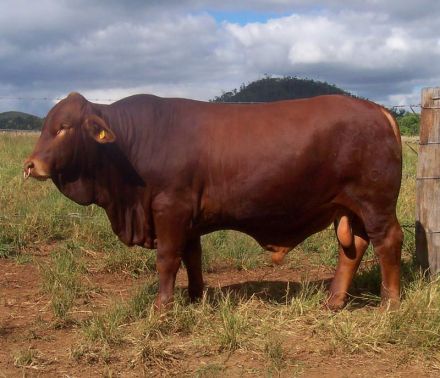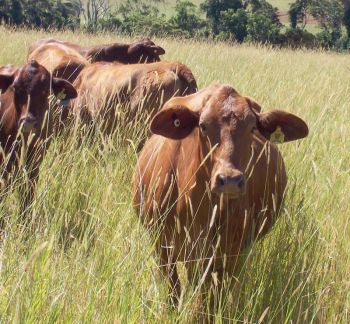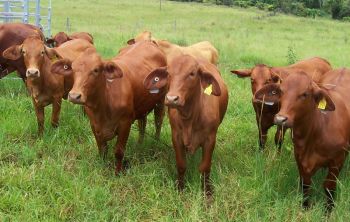Droughtmaster Charcteristics
The Droughtmaster combines the best characteristics of both the British (Bos taurus) and Tropical Bos indicus breeds to produce high quality beef economically. Astute northern cattlemen set about crossing the hardy red Zebu cattle, a Bos indicus breed, with traditional British breeds, like the Shorthorn, early last century. After many years of selection evolved a highly adaptable, productive, fertile and docile breed in the Droughtmaster. The Droughtmasters' superior adaptation comes principally from traits of heat tolerance, insect resistance, a short-haired coat, ease of calving and digestive efficiency.
Heat Tolerance
This is a major economic factor, because when the body temperature rises, so too does the stress level with its associated waste of energy reserves, increased water consumption and reduced feed intake. Heat tolerance in the Droughtmaster comes from:
- Short-haired coat;
- Increased number and size of sweat glands;
- Large area of loose skin;
- A slow metabolic rate.
Parasite resistance
Both internal and external parasites are very expensive to control, so Droughtmaster with their resistance to parasites hold a substantial economic advantage. Although developed originally to be resistant to ticks, the Droughtmaster has shown a resistance to most other external and internal parasites in more recent times. Parasite resistance comes through:
- Chemicals in sweat glands provide a repellent action;
- Shorthaired coat deters attachment;
- Immune response to internal and external parasites.
Digestive efficiency
Most beef production areas of the world suffer a nutrient deficit at some stage, and in some cases the deficit is virtually constant. The Droughtmaster has inherited a digestive system, which combined with excellent walking and foraging abilities, allows Droughtmasters to continue growing and breeding in spite of low nutrient levels. The digestive efficiency comes through:
- Small first stomach;
- Slow metabolic rate creates low feed requirements;
- Recycling of nutrients through blood stream;
- Reduced water consumption produces increased nitrogen;
- Slow rate of protein turnover allows development levels to occur on low nutrients.
These factors also give the Droughtmaster a greater feed conversion efficiency, which is important even when nutrient is in ample supply.
Calving Ease
Easy calving eliminates the need for human intervention, thus reducing time and management costs. It also ensures low cow wastage and reduces 'passengers' in the breeding herd.
Calving ease makes Droughtmaster cows very suitable for crossing with high growth sires, and Droughtmaster bulls pass on the important characteristics of calf shape and low birth weights when used with other breeds. The subsequent F1 females are renowned as efficient dams, very suitable for joining to high growth sires.
Red Pigment
The red pigmentation in Droughtmasters is reputed to protect the cattle from the harmful rays of the sun, thus reducing the incidence of eye disorders and photosensitization.
Hooded eyes
The deeply recessed or hooded eye of the Droughtmaster minimises damage from bumping and spiking, and provides some protection from crawling and biting insects, as well as reducing the occurrence of eye cancers, blight and pinkeye.The ability to adapt to adverse environments has given Droughtmasters a well-justified reputation for hardiness.
Carcass Attributes & Meat Quality
Droughtmasters are also noted for their well muscled carcasses with optimum fat cover; give Droughtmasters excellent dressing percentages and high saleable meat yields. Recent trial results produced dressing percentages of 58% and saleable meat yields of 76%. With Shorthorn in its background, marbling performance is among the highest of the Bos indicus derived breeds producing high quality, tender beef that grades well under the current MSA Cuts Based Grading System. High growth performance and extended ageing of cuts can produce EQS 5 star grading. Numerous wins in carcass competitions across Australia confirm this performance.
Breeding fertile, tropically adapted, well muscled cattle that produce tender beef




